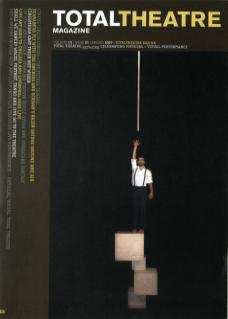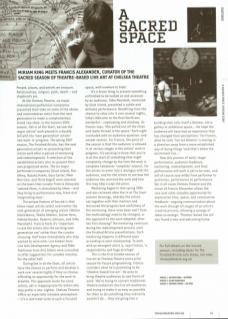People, places, and beliefs we treasure. Relationships, religion, punk, death – and shepherd’s pie.
At the Chelsea Theatre, six major international performers/companies presented their take on some of the above, and nominated an artist from the next generation to make a complementary brand new show. In the autumn 2006 season, Get in at the Start, we saw the major artists’ work placed in a double bill with the ‘next generation’ artists’ new work-in-progress. The spring 2007 season, The Finished Article, has the next generation artists re-presenting their initial work after a period of mentoring and redevelopment. A selection of the established artists also re-present their own progressed works. The six major performers/companies (Goat Island, Ron Athey, Kazuko Hohki, Gary Carter, Mem Morrison, and Third Angel) were selected on the basis that curator Francis Alexander ‘adored them, is stimulated by them – and they bring to performance new, fresh and invigorating ways’.
The unique feature of Sacred is that these major artists select and mentor the next generation of emerging artists (Meline Danielewicz, Sheila Ghelani, Action Hero, Helena Hunter, Dominic Johnson, and Silke Mansholt). Francis feels it’s ‘important to ask the artists who the exciting next generation are’ rather than the curator choosing. Half knew immediately who they wanted to work with; Lois Kiedan from Live Arts Development Agency and Nikki Tomlinson from Arts Admin were consulted to offer suggestions for suitable matches for the other half.
During Get in at the Start, all artists have the chance to perform and develop a work over several nights if they so choose, affording an opportunity for the work to breathe. This approach works for some artists, yet is inappropriate for others who may prefer a one-nighter. Chelsea Theatre offers an especially intimate atmosphere – it’s a rare treat to be in such a focused space, with nowhere to hide!
It’s a brave thing to present something unfinished to be looked at and assessed by an audience. Silke Mansholt, mentored by Goat Island, presented a subtle and delicate performance. Benefiting from the chance to relax into it over several nights, Silke’s Welcome to the Real World was wonderful – captivating and shadowy. As Francis says, ‘She pulled out all the stops and really thrived in the space.’ Each night concluded with an audience question-and-answer session. For Francis, the point of the season is that the audience is allowed in at various stages in the artists’ work in progress. It’s exciting to know that you’re in at the start of something that might completely change by the time the work is complete (whatever ‘complete’ means), for the artists to enter into a dialogue with the audience, and for the artists to see how the audience has received the work and how this may help sculpt the piece.
Mentoring began in late spring 2006 and was reviewed after the In at The Start autumn showings, whereby the artists sat together with their mentors and discussed the progress and usefulness of the mentoring. Have aims been met? Does the methodology need to be changed, or the approach to the work adapted, after the first showing? The mentoring continues during the redevelopment process until the Finished Article presentations. Each mentoring happens in different ways according to each relationship. To work with an emergent artist is, says Francis, ‘a responsibility and huge privilege’.
This is the first funded season of live art at Chelsea Theatre and a pilot season for future programming. Francis considers what he is promoting to be ‘theatre-based live art’. He aims to bring theatre audiences to new forms of work: ‘We’re trying to convert traditional theatre audiences into live art audiences and trying to make it as easy as possible for them to do something they ordinarily wouldn’t do... they are going into a building that calls itself a theatre, not a gallery or exhibition space... We hope the audience will have had an experience that has changed their perceptions.’ For Francis, what he calls ‘live art theatre’ is moving in a direction away from a more established way of doing things ‘and that’s where the excitement lies…’
How this process of early-stage performance, audience feedback, mentoring, redevelopment, and final performance will work is yet to be seen, and will of course vary wildly from performer to performer, performance to performance. Yet in all cases Chelsea Theatre and the vision of Francis Alexander allows the rare and richly valuable opportunity for explorative time, space, and constructive feedback– ongoing communication about the work through all stages of an artist’s creative process, allowing a synergy of ideas to emerge. ‘Theatre-based live art’ has found a new and welcoming home.
For full details on the Sacred season, including dates for The Finished Article solo shows, see www.chelseatheatre.org.uk

